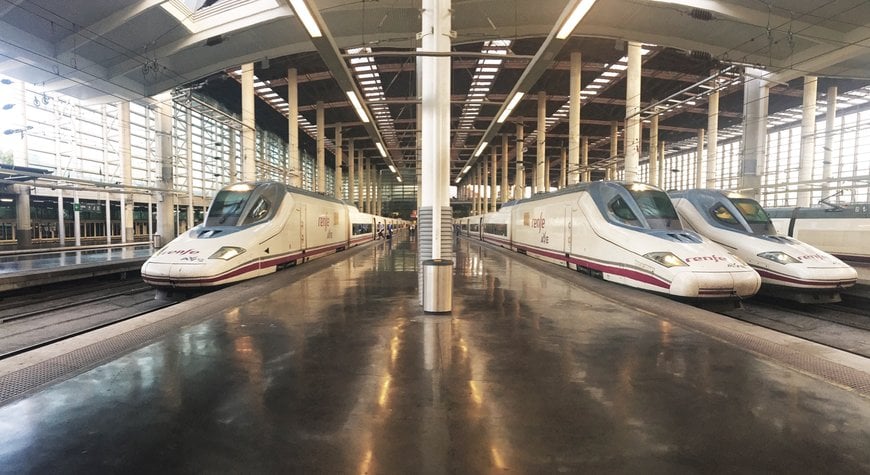Talgo offers its innovation to set rail as the safest transport mode in face of the COVID-19 pandemic
Talgo, the leading Spanish high-speed train designer and manufacturer, reminds that the transport mode that is better suited to deal with the operating conditions needed to fight the spread of the COVID-19 is rail.

- Passengers on a Talgo train enjoy double air volume than those in a typical plane
- They are distributed in 12 independently ventilated, accessed spaces instead of a single one
- The Spanish company is developing and deploying a set of technologies to fight COVID-19
Several internal studies carried out by the company have confirmed that railways, as compared with other transport modes, can guarantee not only the maximum possible social distancing but are also better suited to purify the air inside the vehicles, both devised as the best tools to prevent the pandemic from expanding.
As Talgo Innovation Director Emilio García puts it: “If we are talking about protecting passengers from COVID-19, we can assure that rail has some features, can combine some protecting measures that simply cannot be implemented in other transport modes –or can only be partially deployed”.
A more intelligent passenger distribution
A key factor would be, García says, the number of spaces in which passengers are distributed in each transport mode, as almost every mode could implement some of the currently available COVID-19 countermeasures. The differentiating element would thus be the specific architecture of trains and the interior space they assign to each passenger.
“By definition, planes have a single interior volume and one, mabye two accesses are used. This makes it impossible to adequately compartmentalize the air passengers inhale and exhale. Consequently, air travelers are forced to share a handful of accesses (most of the times that would be just one one) and a single space for around 150 people all the trip long”, if a typical plane of those used in the Madrid-Barcelona corridor is taken as reference.
“In rail, a number of coaches in every modern train allows to naturally and uniformly distribute accesses” and what is more important for this Engineering PhD and Executive MBA: “all of them are independently ventilated, with separate HVAC systems”.
Talgo trains: less density, more air
This is especially significant in Talgo trains which, because of their unique technology, are the shortest and widest in the rail market. Using the Madrid-Barcelona corridor already set as an example a classic, typical high-speed train with a length of 200m distributes passengers in eight different coaches. Given the same length, Talgo trains increase the number of compartments by a full 50%, up to 12 coaches.
And every single coach is equipped with its own, separate HVAC system, thus reducing massive passenger exposure risk and guaranteeing the best hygienic conditions.
A Talgo train is therefore capable of transporting 365 passengers in 12 separate blocks, as compared with 150 passengers in a single volume in a single shared space for the reference plane.
In terms of air volume per passenger, a Talgo train can offer up to double the cubic meters per head than a plane. And that would be even more for Avril train currently being manufactured for Renfe, the widest of its category in the Euro-standard loading-gauge.
Talgo Innovation Director summarizes all the advantages: “A Talgo train distributes passengers in 12 separate spaces instead of a single one for a plane, all of them with independent air entries and filtering, has multiple accesses along the vehicle and additionally reduces exposition by offering double the free air per passenger”.
The train, immediate response
Long before the current pandemic was declared, and as a result of the general public acknowledgment of the perils climate emergency poses, a number of studies were already pointing to an increasing appeal of rail for travelers in Europe.
Latter studies carried out once the pandemic had fully unraveled in Europe have confirmed that the modal shift from planes to trains in the 600-800km trip range would not only keep occurring because of environmental concerns but will be accelerated as a consequence of increased concerns about health and safety in light of the COVID-19 expansion.
Those new preferences for consumers, more belligerent in face of climate change, more concerned for their own safety and more responsible with public health, will no doubt be reflected in the short and medium term in European railway systems as they will have to cope with an increased and more challenging demand.
It is in this environment where Talgo has been developing during the last months a set of technologies for train operating companies that are willing to implement a reinforced hygienic and comfort offering. Those technologies are devised to prevent passenger exposure and include full vehicle disinfection in every surface and optimal interior air quality.
www.talgo.com

